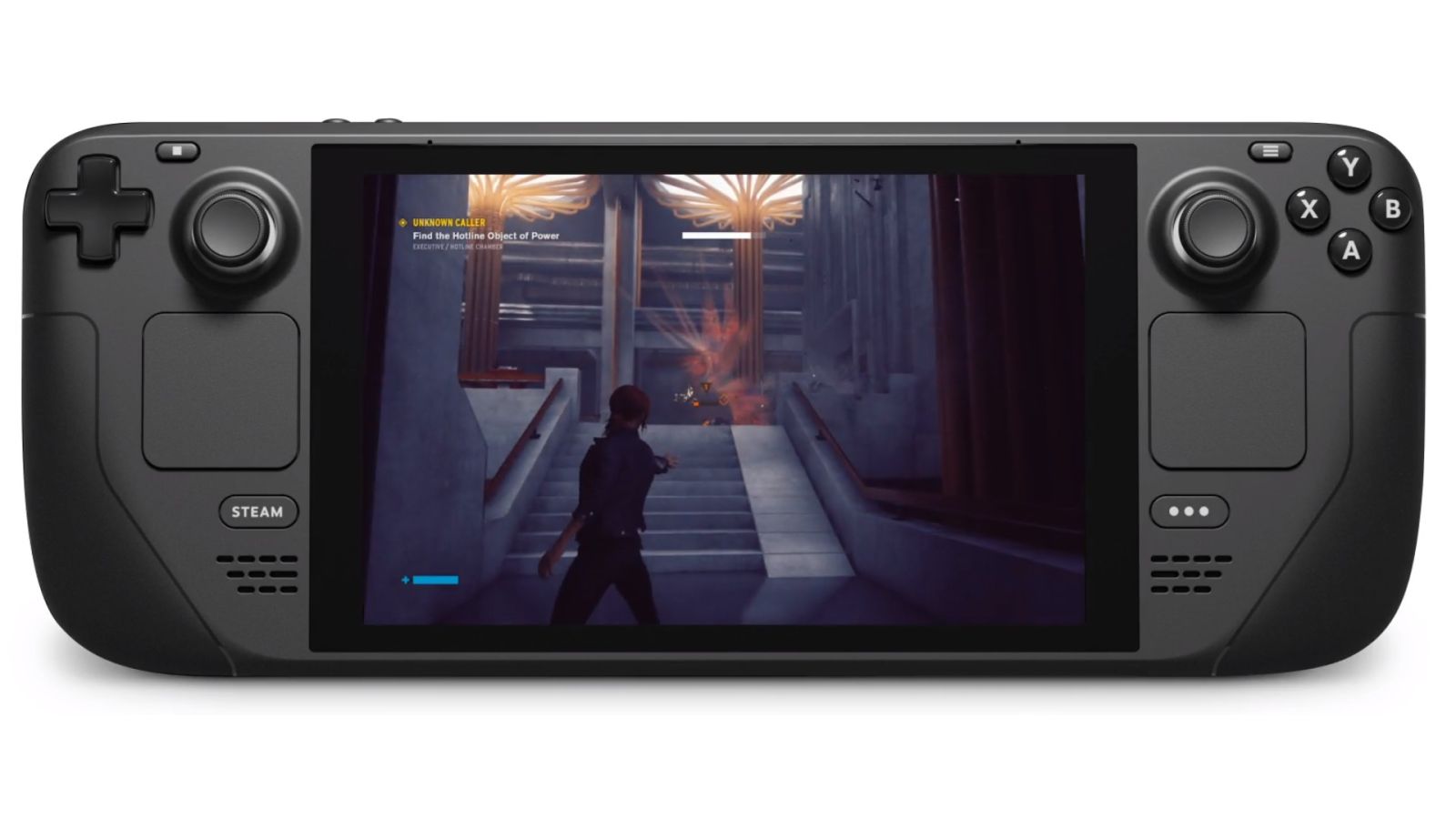Steam Deck:Valve進軍掌機市場的野心之作
Steam Deck:Valve進軍掌機市場的野心之作
Steam Deck是由Valve公司於2022年2月正式推出的掌上型遊戲主機,旨在讓玩家能夠在移動設備上暢玩PC遊戲庫。不僅延續Valve在PC遊戲分發平臺Steam 上的優勢,更試圖打破傳統掌機與PC之間的界限,成為真正意義上的“可擕式PC遊戲機”。
1. 硬體規格與設計
Steam Deck的核心競爭力在於其強大的硬體設定,使其能夠流暢運行許多現代 PC 遊戲。搭載AMD定制的APU(Zen 2 CPU + RDNA 2 GPU),性能接近上一代遊戲主機(如 Xbox Series S),並配備7英寸1280×800解析度LCD螢幕(後續OLED 版本提升至90Hz刷新率)。存儲方面提供64GB eMMC、256GB NVMe SSD和512GB NVMe SSD三種版本,並支持microSD卡擴展。設備採用類似Nintendo Switch的佈局,但更偏向PC遊戲操控,包括兩個觸控板(類比滑鼠操作)、四個背鍵、陀螺儀瞄準,以及完整的搖杆和按鍵佈局。此外,Steam Deck 運行基於Linux 的SteamOS 3.0,但允許用戶安裝 Windows,使其兼具PC的開放性與掌機的便攜性。
2. 市場定位與銷售表現
Steam Deck的定價策略極具競爭力,基礎版399美元(64GB eMMC),高階版649 美元(512GB NVMe SSD + 防眩光螢幕)。相比同類產品(如 ASUS ROG Ally 或 Ayaneo 掌機),它的價格更親民,同時性能足夠應對大部分Steam遊戲庫。根據Valve官方資料,Steam Deck在2022年銷量突破300萬台,並在2023年推出OLED版本後進一步增長。雖然遠低於Nintendo Switch的銷量(1.4 億台),但它在PC掌機市場佔據主導地位,並成功吸引一批核心PC玩家。
3. 遊戲相容性與軟體生態
Steam Deck的最大優勢在於其龐大的Steam遊戲庫支持。Valve通過Proton(基於Wine的相容層)讓大量Windows遊戲能在Linux系統上運行,官方認證的“Deck Verified”遊戲已超過10,000款,包括《艾爾登法環》《賽博朋克 2077》等3A作品。然而,並非所有遊戲都能完美運行,部分反作弊系統(如《命運 2》《Apex英雄》)仍存在相容性問題。此外,由於硬體限制,某些高需求遊戲(如《星空》)需要調低畫質才能流暢遊玩。
4. 市場評價:創新與爭議並存
優點:
強大的便攜PC體驗:能在掌機上玩到Steam遊戲庫,無需額外購買遊戲。
開放的PC架構:允許安裝Windows、Epic Games Store等其他平臺,甚至可當作小型Linux電腦使用。
高性價比:相比其他PC掌機(如ROG Ally售價699美元),Steam Deck更具價格優勢。
缺點:
體積與重量:相比Switch,Steam Deck更厚重(約669克),長時間握持較累。
電池續航:高性能遊戲下僅能維持1.5-2小時,低功耗模式約4-6小時。
部分遊戲優化不足:非“Deck Verified”遊戲可能需要手動調整設置。
5. 競爭對手與未來展望
Steam Deck的成功催生PC掌機市場的競爭,包括:
ASUS ROG Ally(2023):採用 Windows 11 + AMD Ryzen Z1,性能更強但價格更高。
Lenovo Legion Go(2023):類似 Nintendo Switch 的可拆卸手柄設計,配備更高解析度螢幕。
Ayaneo / GPD Win 系列:主打高端市場,但價格昂貴。
Valve已表明將繼續反覆運算Steam Deck,未來可能推出性能更強的版本。隨著 AMD 新APU和更高效制程的進步,下一代Steam Deck有望在性能與續航上取得更大突破。
結論:重新定義掌上遊戲的可能性
Steam Deck並非傳統意義上的“掌機”,而是Valve對“可擕式PC遊戲”的一次大膽嘗試。成功填補Nintendo Switch 與高端遊戲筆記本之間的市場空白,讓玩家能在移動設備上享受PC遊戲的自由與多樣性。儘管存在續航和重量等問題,但其開放的生態系統、強大的遊戲相容性,以及相對合理的價格,使其成為目前最受歡迎的PC掌機。未來,隨著技術改進和更多廠商加入競爭,這市場可能會進一步擴大,而Steam Deck已經證明,掌上設備不僅能玩獨立遊戲,還能運3A大作。
Steam Deck: Valve’s Ambitious Foray into the Handheld Console Market
The Steam Deck is a handheld gaming console developed by Valve, officially released in February 2022. Designed to allow players to enjoy their PC game libraries on the go, it not only extends Valve’s dominance in digital game distribution through Steam but also seeks to break the traditional boundaries between handheld consoles and PCs—positioning itself as a true “portable PC gaming machine.”
1. Hardware Specifications and Design
At the core of the Steam Deck’s appeal is its impressive hardware configuration, which enables it to run many modern PC games smoothly. It features a custom APU developed with AMD (Zen 2 CPU + RDNA 2 GPU), delivering performance on par with previous-generation consoles like the Xbox Series S. The device sports a 7-inch LCD display with a resolution of 1280×800 (later upgraded to a 90Hz OLED screen in the revised model). Storage options include 64GB eMMC, 256GB NVMe SSD, and 512GB NVMe SSD, with microSD expansion available.
Its design resembles the Nintendo Switch but leans more towards PC-style controls. It includes dual trackpads (simulating mouse input), four back buttons, gyro aiming, and a full set of analog sticks and buttons. The Steam Deck runs SteamOS 3.0, a Linux-based operating system, but it also allows users to install Windows, combining the openness of a PC with the portability of a handheld device.
2. Market Positioning and Sales Performance
Valve adopted an aggressive pricing strategy, with the base model starting at $399 (64GB eMMC) and the high-end model priced at $649 (512GB NVMe SSD with anti-glare display). Compared to similar devices like the ASUS ROG Ally or Ayaneo handhelds, the Steam Deck is significantly more affordable while still offering strong performance across most of the Steam library.
According to Valve, the Steam Deck sold over 3 million units in 2022. With the release of the OLED model in 2023, sales continued to rise. While it doesn’t approach the astronomical 140 million units sold by the Nintendo Switch, the Steam Deck has dominated the handheld PC market and attracted a loyal base of core PC gamers.
3. Game Compatibility and Software Ecosystem
One of the Steam Deck’s greatest strengths lies in its massive compatibility with the Steam game library. Through Proton—a compatibility layer based on Wine—Valve has enabled thousands of Windows-based games to run on Linux. Over 10,000 titles have received “Deck Verified” status, including major AAA titles such as Elden Ring and Cyberpunk 2077.
However, not all games run flawlessly. Some titles with strict anti-cheat systems, such as Destiny 2 and Apex Legends, still face compatibility issues. Additionally, due to hardware limitations, more demanding games like Starfield require graphical settings to be lowered for smooth gameplay.
4. Market Reception: Innovation and Controversy
Pros
· Powerful portable PC experience: Play your Steam library on the go without needing to repurchase games.
· Open PC architecture: Install Windows, the Epic Games Store, or use it as a compact Linux PC.
· High cost-performance ratio: Compared to other handheld PCs like the ROG Ally ($699), the Steam Deck offers better value for money.
Cons
· Size and weight: Heavier than the Switch (around 669g), which may cause fatigue during extended play.
· Battery life: High-performance titles drain the battery in just 1.5–2 hours; lighter use extends this to 4–6 hours.
· Game optimization: Non-“Deck Verified” games may require manual tweaking for optimal performance.
5. Competitors and Future Outlook
The success of the Steam Deck has sparked increased competition in the handheld PC gaming space, including:
· ASUS ROG Ally (2023): Runs Windows 11 with an AMD Ryzen Z1 processor—more powerful but significantly more expensive.
· Lenovo Legion Go (2023): Features detachable controllers like the Switch and a higher-resolution display.
· Ayaneo / GPD Win series: Targets the high-end niche but at a premium price.
Valve has confirmed it will continue iterating on the Steam Deck, with future versions expected to feature better performance and battery efficiency. Thanks to advancements in AMD’s APU technology and smaller manufacturing processes, the next-generation Steam Deck could significantly improve both performance and endurance.
Conclusion: Redefining the Possibilities of Handheld Gaming
The Steam Deck isn’t a handheld console in the traditional sense—it’s Valve’s bold attempt to redefine what portable PC gaming can be. By bridging the gap between the Nintendo Switch and high-end gaming laptops, the Steam Deck offers players the freedom and versatility of PC gaming in a compact form. While not without its flaws—such as limited battery life and bulk—it stands out thanks to its open ecosystem, extensive game compatibility, and reasonable pricing. As technology evolves and more manufacturers enter the market, handheld gaming PCs are likely to become a major category—and the Steam Deck has already proven that even AAA titles can thrive in the palm of your hand.

照片:產品官網
- 1
- 2
- 3
- 4
